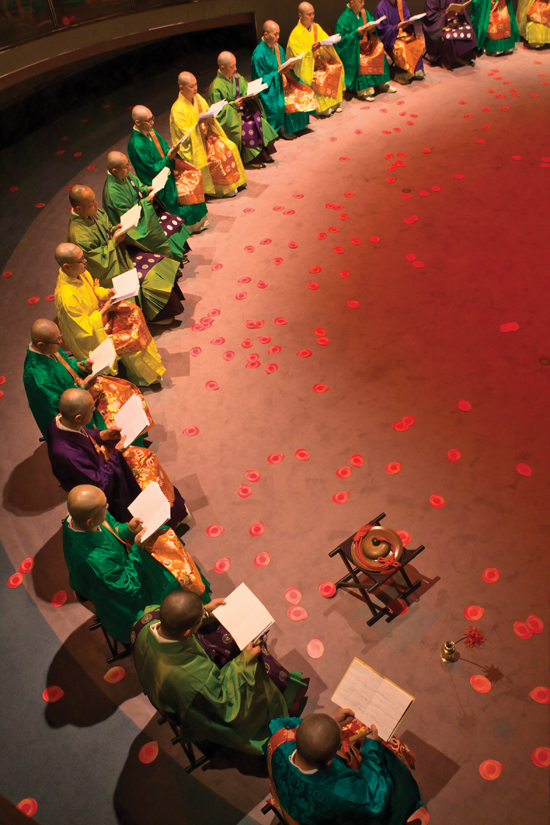For many Western Buddhists, chanting is a regular part of practice. But few perhaps are familiar with chant’s long and illustrious history in Japanese Buddhism. All that may change this March, when Shomyo no Kai–Voices of a Thousand Years embarks on its first North American tour, produced and organized by Japan Society in New York City. The chorus of two dozen priests from the Shingon and Tendai sects performs traditional shomyo—Buddhist ritual chanting—along with shomyo-inspired works by contemporary composers.
Shomyo, literally “voice clear,” is a style of melodic chanting based on sacred texts. It originated in India, later migrating to Japan from China and Korea sometime after Buddhism arrived in the mid-6th century CE. The earliest documented shomyo performance was in 752. But it wasn’t until sometime in the Heian period (9th to 12th centuries) that shomyo really took hold, after successors to Saicho, founder of the Tendai sect, and Kukai, founder of Shingon, completed notation systems for the shomyo styles of their respective traditions. These remain the dominant shomyo styles today.
As sacred liturgy, shomyo was traditionally performed only in Buddhist monasteries and the emperor’s court. Therefore, it was unfamiliar even to most Japanese in 1966, when temple priests gave the first public performance of the traditional chants at the newly founded National Theatre in Tokyo. Religious conservatives were outraged, but that didn’t deter the Shingon grand priest, Yuko Aoki. He was in favor of performing “anyplace where people will listen to shomyo with a receptive heart and mind,” explains Kojun Arai, a Shingon priest who accompanied Yuko Aoki on the first shomyo world tour in 1973.
Kojun Arai was also a founder of the monk’s choir Shomyo Yonin no Kai in 1997. (The name was changed to Shomyo no Kai–Voices of a Thousand Years in 2003, as a new generation of members joined.) Their mission is not only to preserve the traditional chants but also to develop shomyo as a secular art form. The monks first came together in 1983 for the premiere of a contemporary shomyo work, À l’Approche du Feu Méditant(Approaching the Meditative Flame), by French composer Jean-Claude Eloy. Since then, they have performed numerous times for lay audiences at home and abroad, recently giving their twentieth concert at Spiral Hall, Tokyo’s foremost contemporary arts center.
Shomyo no Kai kicks off its North American visit on March 2, at Haverford College in Pennsylvania. They will appear in New York City on March 6 for a concert at Saint Bartholomew’s Church co-presented by Japan Society and the Mid-Manhattan Performing Arts Foundation. On March 8, at the John F. Kennedy Center for the Performing Arts in Washington, DC, they will perform Ushio Torikai’s contemporary piece, Life in an Autumn, written in the wake of 9/11.
Thank you for subscribing to Tricycle! As a nonprofit, we depend on readers like you to keep Buddhist teachings and practices widely available.
